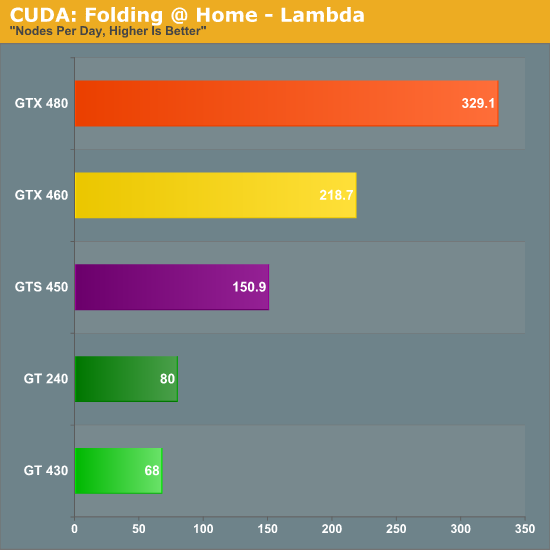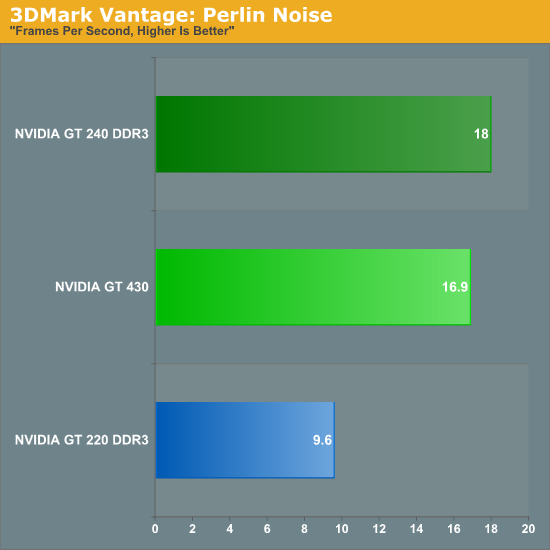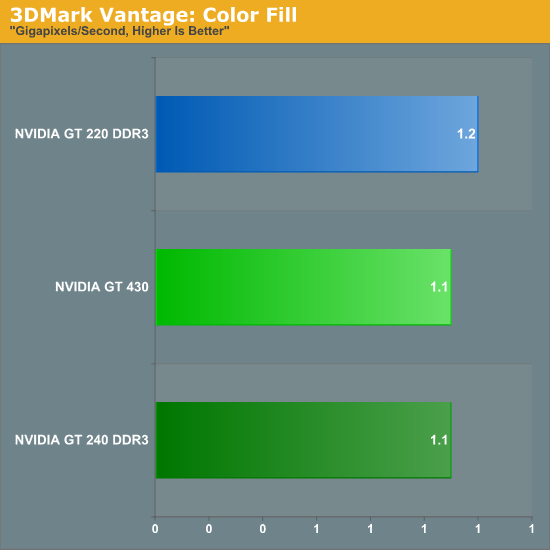NVIDIA's GeForce GT 430: The Next HTPC King?
by Ryan Smith & Ganesh T S on October 11, 2010 9:00 AM ESTCompute Performance & Synthetics
While the GT 430 isn’t meant to be a computing monster and you won’t see NVIDIA presenting it as such, it’s still a member of the Fermi family and possesses the family’s compute capabilities. This includes the Fermi cache structure, along with the 48 CUDA core SM that was introduced with GF104/GTX 460. This also means that it has a greater variation of performance than the past-generation NVIDIA cards; the need to extract ILP means the card performs between a 64 CUDA core card and a 96 CUDA core card depending on the application.
Meanwhile being based on the GF104 SM, the GT 430 is FP64 capable at 1/12th FP32 speeds (~20 GFLOPS FP64), a first for a card of this class.
For our look at compute performance we’ll turn to our trusty benchmark copy of Folding @ Home. We’ve also included the GT 240, a last-generation 96 CUDA core card just like the GT 430. This affords us an interesting opportunity to see the performance of Fermi compared to GT200 with the same number of CUDA cores in play, although GT 430 has a clockspeed advantage here that gives it a higher level of performance in theory.

The results are interesting, but also a bit distressing. GT 430’s performance as compared to the GTS 450’s performance is quite a bit lower, but this is expected. GT 240 however manages to pull ahead by nearly 17%, which is quite likely a manifestation of Fermi’s more variable performance. This makes the GT 220 comparison all the more appropriate, as if Fermi’s CUDA cores are weaker on average then GT 430 can’t hope to keep pace with GT 240.
To take a second look at CUDA core performance, we’ve also busted 3DMark Vantage out of the vault. As we’ve mentioned before we’re not huge fans of synthetic tests like 3DMark since they encourage non-useful driver optimizations for the benchmark instead of real games, but the purely synthetic tests do serve a useful purpose when trying to get to the bottom of certain performance situations.
We’ll start with the Perlin Noise test, which is supposed to be computationally bound, similar to Folding @ Home.

Once more we see the GT 430 come in behind the GT 240, even though the GT 430 has the theoretical advantage due to clockspeed. The loss isn’t nearly as great as it was under Folding @ Home, but this lends more credit to the theory that Fermi shaders are less efficient than GT21x CUDA cores. As a card for development GT 430 still has a number of advantages such as the aforementioned FP64 support and C++ support in CUDA, but if we were trying to use it as a workhorse card it looks like it wouldn’t be able to keep up with GT 240. Based on our gaming results earlier, this would seem to carry over to shader-bound games, too.
Moving on, we also used this opportunity to look at 3DMark Vantage’s color fill test, which is a ROP-bound test. With only 4 ROPs on the GT 430, this is the perfect synthetic test for seeing if having fewer ROPs really is an issue when we’re comparing GT 430 to older cards.

And the final verdict? A not very useful yes and no. GT 220 and GT 240 both have 8 ROPs, with GT 220 having the clockspeed advantage. This is why GT 220 ends up coming out ahead of GT 240 here by less than 100 MPixels/sec. But on the other hand, GT 430 has a clockspeed advantage of its own while possessing half the ROPs. The end result is that GT 430 is effectively tied with these previous-generation cards, which is actually quite a remarkable feat for having half the ROPs.
NVIDIA worked on making the Fermi ROPs more efficient and it has paid off by letting them use 4 ROPs to do what took 8 in the last generation. With this data in hand, NVIDIA’s position that 4 ROPs is enough is much more defensible, as they’re at least delivering last-generation ROP performance on a die not much larger than GT216 (GT 220). This doesn’t provide enough additional data to clarify whether the ROPs alone are the biggest culprit in the GT 430’s poor gaming performance, but it does mean that we can’t rule out less efficient shaders either.
Do note however that while Fermi ROPs are more efficient than GT21x ROPs, it’s only a saving grace when doing comparisons to past-generation architectures. GT 430 still only has ¼ the ROP power as GTS 450, which definitely hurts the card compared to its more expensive sibling.










120 Comments
View All Comments
heflys - Tuesday, October 12, 2010 - link
BTW, I've only had problems with one card. A nvidia 6600 GT or something.....The fan burnt out, and the card starting getting real hot. You can guess the rest. It was getting old though.dnd728 - Wednesday, October 13, 2010 - link
With fresh new Windows 7 install it would for example never wake up right from sleep - it may permanently freeze or refuse to log in or log in keeping the log-in screen and stop responding, artifacts may also show up.In XP none of that happens, but frequently and sporadically the VPU would crash and get restarted. No need stressing the GPU or CPU at all. It would also break the anti-keylogging software. Get the card out, and everything is back to normal.
khimera2000 - Thursday, October 14, 2010 - link
Never had these issues with my 5970 on win 7.khimera2000 - Thursday, October 14, 2010 - link
sorry 5870 not 5970.dnd728 - Thursday, October 14, 2010 - link
Well, obviously they're working for most people.The question was, why so many people buy nvidia, and I gave one reason, my personal one - not because I love nvidia, but because the comparable AMD does not work for me. Give me any third competitor, and I'll give them a try. :)
extide - Tuesday, October 12, 2010 - link
If you are constantly crashing windows, (blue screens), then you have bad hardware whatever is broken it needs to be replaced.dnd728 - Tuesday, October 12, 2010 - link
True, that's how I know it's ATI/AMD.extide - Tuesday, October 12, 2010 - link
It's not ATI/AMD, you may have happened to have a bunch of bad AMD/ATI cards yourself that were bad (in which case you would be extremely un-lucky and I actually highly doubt that is the case), but they in general are NOT. I have ran both, and even 3dfx back in the day. Currently my box at work uses a 4350, 100% stable (4Ghz i7/X58), never blue screens, and my pc at home has had MANY configs (single 4850, dual 4850, single 4870, single 4350, etc) NONE of them caused stability problems, and I have ran many many many driver versions over time . I am not insulting you or your intelligence but I am saying if you are getting blue screens in windows these days you have bad hardware or a bad driver. The ATI driver is not bad/broken, period.I'm not even a fanboy I have owned products from both vendors and my next may be an ATI/AMD one or an nVidia one, I haven't decided yet and I dont really consider stability to be a part of the decision as neither one of these companies make straight up un-reliable stuff. Infact last card I had was an 8800GT and then before that was an ATIX1950Pro in crossfire, and prior was just a single X1950Pro, and prior was a gf4 ti4200, then prior was a gf3 ti200, then prior was a voodoo 5 5500, and prior was a voodoo 3 3500, and I had many card before that too. That's just my main machine....
There IS something bad in your machine, don;t take it as an insult, be mature about it and just figure it out dude.
I remember years ago I was working on a machine that used RAMBUS, and I dont know if you are familiar with those but they required terminators in un-used ram slots. It had stability issues, I tried everything eventually pretty much swapped out all the hardware. It ended up being bad terminators in the empty ram slots. Weird stuff can and does happen with computers.
extide - Tuesday, October 12, 2010 - link
Sorry, the 4Ghz i7/X58/6GB is my main pc at home, and my box at work is a Q9400/Q45/8GBdnd728 - Wednesday, October 13, 2010 - link
All of my machines plus a few others being defective in a way that would not allow them to accept ATI, but only competing brands? That's even less likely.If your car keeps breaking while driving road x, and nowhere else, then at first you say - a coincidence, then you look for a reason and decide - bad luck, but eventually you just avoid that road. Even if many other drivers are happy with it. It's not worth it.